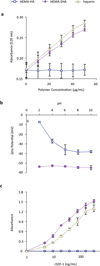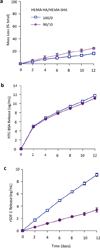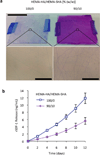Incorporation of Sulfated Hyaluronic Acid Macromers into Degradable Hydrogel Scaffolds for Sustained Molecule Delivery
- PMID: 24955239
- PMCID: PMC4060972
- DOI: 10.1039/C3BM60227C
Incorporation of Sulfated Hyaluronic Acid Macromers into Degradable Hydrogel Scaffolds for Sustained Molecule Delivery
Abstract
Synthetically sulfated hyaluronic acid (HA) has been shown to bind proteins with high affinity through electrostatic interactions. While HA-based hydrogels have been used widely in recent years for drug delivery and tissue engineering applications, incorporation of sulfated HA into these networks to attenuate the release of proteins has yet to be explored. Here, we developed sulfated and methacrylate-modified HA macromers and incorporated them into HA hydrogels through free radical-initiated crosslinking. The sulfated HA macromers bound a heparin-binding protein (i.e., stromal cell-derived factor 1-α, SDF-1α) with an affinity comparable to heparin and did not alter the gelation behavior or network mechanics when copolymerized into hydrogels at low concentrations. Further, these macromers were incorporated into electrospun nanofibrous hydrogels to introduce sulfate groups into macroporous scaffolds. Once incorporated into either uniform or fibrous HA hydrogels, the sulfated HA macromers significantly slowed encapsulated SDF-1α release over 12 days. Thus, these macromers provide a useful way to introduce heparin-binding features into radically-crosslinked hydrogels to alter protein interactions for a range of applications.
Figures








Similar articles
-
Sulfated hyaluronic acid hydrogels with retarded degradation and enhanced growth factor retention promote hMSC chondrogenesis and articular cartilage integrity with reduced hypertrophy.Acta Biomater. 2017 Apr 15;53:329-342. doi: 10.1016/j.actbio.2017.02.015. Epub 2017 Feb 11. Acta Biomater. 2017. PMID: 28193542
-
Semi-interpenetrating networks of hyaluronic acid in degradable PEG hydrogels for cartilage tissue engineering.Acta Biomater. 2014 Aug;10(8):3409-20. doi: 10.1016/j.actbio.2014.04.013. Epub 2014 Apr 24. Acta Biomater. 2014. PMID: 24769116
-
Hyaluronan/collagen hydrogels containing sulfated hyaluronan improve wound healing by sustained release of heparin-binding EGF-like growth factor.Acta Biomater. 2019 Mar 1;86:135-147. doi: 10.1016/j.actbio.2019.01.029. Epub 2019 Jan 17. Acta Biomater. 2019. PMID: 30660005
-
Synergistic effects of SDF-1α chemokine and hyaluronic acid release from degradable hydrogels on directing bone marrow derived cell homing to the myocardium.Biomaterials. 2012 Nov;33(31):7849-57. doi: 10.1016/j.biomaterials.2012.07.005. Epub 2012 Jul 24. Biomaterials. 2012. PMID: 22835643 Free PMC article.
-
Recent advances in hyaluronic acid hydrogels for biomedical applications.Curr Opin Biotechnol. 2016 Aug;40:35-40. doi: 10.1016/j.copbio.2016.02.008. Epub 2016 Feb 27. Curr Opin Biotechnol. 2016. PMID: 26930175 Review.
Cited by
-
Basement Membrane Mimetic Hydrogel Cooperates with Rho-Associated Protein Kinase Inhibitor to Promote the Development of Acini-Like Salivary Gland Spheroids.Adv Nanobiomed Res. 2023 Nov;3(11):2300088. doi: 10.1002/anbr.202300088. Epub 2023 Oct 8. Adv Nanobiomed Res. 2023. PMID: 38645834 Free PMC article.
-
Hyaluronic acid as a versatile building block for the development of biofunctional hydrogels: In vitro models and preclinical innovations.Mater Today Bio. 2025 Feb 18;31:101596. doi: 10.1016/j.mtbio.2025.101596. eCollection 2025 Apr. Mater Today Bio. 2025. PMID: 40083836 Free PMC article.
-
Sulfated GAG mimetic peptide nanofibers enhance chondrogenic differentiation of mesenchymal stem cells in 3D in vitro models.Regen Biomater. 2022 Nov 7;10:rbac084. doi: 10.1093/rb/rbac084. eCollection 2023. Regen Biomater. 2022. PMID: 36683737 Free PMC article.
-
Tissue engineering strategies for promoting vascularized bone regeneration.Bone. 2016 Feb;83:197-209. doi: 10.1016/j.bone.2015.11.011. Epub 2015 Nov 19. Bone. 2016. PMID: 26608518 Free PMC article. Review.
-
Vitreous Substitutes as Drug Release Systems.Transl Vis Sci Technol. 2022 Sep 1;11(9):14. doi: 10.1167/tvst.11.9.14. Transl Vis Sci Technol. 2022. PMID: 36125790 Free PMC article. Review.
References
Grants and funding
LinkOut - more resources
Full Text Sources
Other Literature Sources

